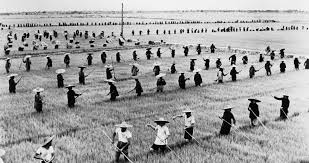Dare to Disappoint: Growing up in Turkey by Ozge Samanci
Ages: Upper Grades (9-12) Lexile: 570
Geographical Setting: Izmir and Istanbul, Turkey
Time Period: 1980s and 1990s
Awards:
Amelia Bloomer Lists - Young Adult Nonfiction (2017)
Middle East Book Award - Youth Literature (2016)
YALSA Great Graphic Novels for Teens (2017)
 |
| Ozge snuck into her sister's class and her mother taking her home. (p. 10) |
 |
| School Stencil showing the importance of Kemal Ataturk and how he must be shown. (p. 40) |
 | ||||
| Class survey showing the students' mothers' occupations. At this young age, Ozge was impressed with 'artist'. (p. 16)
|
 |
| By the time she graduated from college, Ozge decided what she needed to do. (p. 189) |
Nonfiction Read-a-Likes (Coming of Age, Turmoil, and Graphic Novel):
Persepolis by Marjane Satrapi. The author depicts her early years in Iran at the start of the Islamic Revolution until her parents send her to Europe. Volume II is about the author’s years in Europe and her return to Iran. (Grades 9-12)
I Remember Beirut by Zeina Abirached. Growing up in war torn Lebanon during the 1980s and ‘90s, the author depicts her life in black and white illustrations. (Grades 9-12)
The Arab of the Future: A Childhood in the Middle East, 1978-1984 by Riad Sattouf. In his own unique style of illustrating, the author describes his early years of traveling back and forth from France, Libya, and Syria following his father’s whims and dreams. (Grades 9-12)
Marzi by Marzena Sowa. Through the humorous illustrations, the author describes her life in 1980’s Poland towards the end of Communist rule. (Grades 9-12)
Nonfiction Read-a-Likes (Coming of Age, Turmoil, and Female Protagonist):
Brown Girl Dreaming by Jaqueline Woodsen. A memoir in verse about growing up in the South during the 1960s, dealing with racism, divorce, religion, sickness, and death. (Grades 6-8)
I am Malala: How One Girl Stood up for Education and Changed the World by Malala Yousafzai. The Pakistani girl who fought for her and other girls’ education against the Taliban resulting in getting shot in the face. She later went on to become the youngest Nobel Peace Prize winner. (Grades 6-8)
I Know Why the Caged Bird Sings by Maya Angelou. An eye-opening autobiography about the racial prejudice in America during the 1930s and '40s. (Grades 9-12)
Red Scarf Girl: A Memoir of the Cultural Revolution by Ji-Li Jiang. The author depicts a direct and crippling portrait of the violent political movement that ruined many lives, including hers, as well as the profound effect on her family. (Grades 7-9)
For more Information:
This would be great to use in a Culture, Political Science, or Comparative Governments class in high school or college. Students can compare and contrast their (or their parents’) lives growing up in the 1980’s and 1990’s in America and Turkey. This book can also be compared and contrasted with the read a likes mentioned above. It was difficult to find actual lesson plans, but those for Persepolis can be adapted and adjusted. Below are two activities I did find for Dare to Disappoint.












